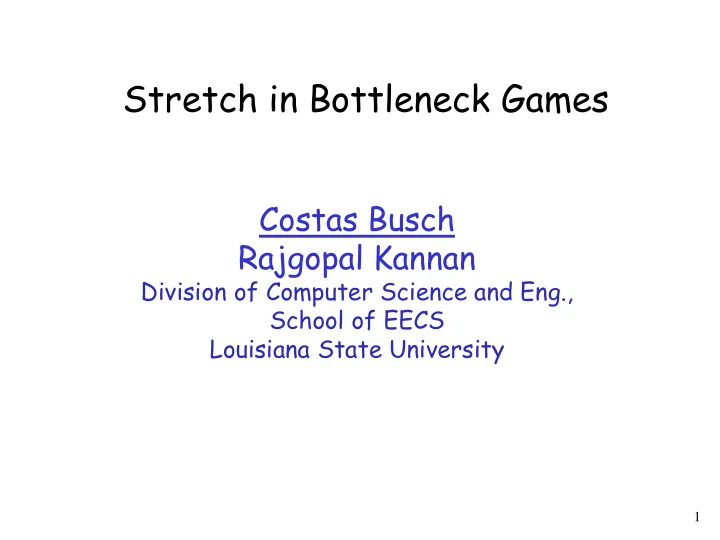

Stretch in Bottleneck Games Costas Busch Rajgopal Kannan Division of Computer Science and Eng., School of EECS Louisiana State University 1
Outline of Talk Introduction General games Linear Games Conclusions 2
Network Routing Each player corresponds to a pair of source-destination Objective is to select paths with small cost 3
Main objective of each player is to minimize congestion: minimize maximum utilized edge player i congestion 3 C 4
Congestion Games: A player may selfishly choose an alternative path that minimizes congestion congestion 1 3 C C 5
Player cost function for routing : p i Congestion pc ( p ) C i i of selected path Social cost function for routing : p SC ( p ) C Largest player cost 6
We are interested in Nash Equilibriums p where every player is locally optimal Metrics of equilibrium quality: Price of Stability Price of Anarchy ( ) SC p ( ) SC p min max * ( ) * SC p p ( ) SC p p is optimal coordinated routing * p with smallest social cost
Previous Result: Costas Busch and Malik Magdon-Ismail, “Atomic Routing Games on Maximum Congestion,” Theoretical Computer Science, August 2009. • Price of Stability is 1 • Price of Anarchy is ( log ) O L n Maximum allowed path length • Price of Anarchy is 2 2 ( log ) O k n k ( Maximum cycle length 1 ) 8
Length of chosen path Stretch= Length of shortest path 12 stretch 1 . 5 8 shortest path u v chosen path 9
Our Results: General bottleneck games: • Price of Anarchy is ( sm ) O stretch Resources (edges) Linear bottleneck games: • Price of Anarchy is ( sm ) O 10
Outline of Talk Introduction General games Linear Games Conclusions 11
Every player can have an arbitrary weight on each resource Strategy weight: The sum of weights of utilized resources Stretch : s Maximum ratio of strategy weights 12
• Price of Anarchy is ( sm ) O • Price of Anarchy is at least ( sm ) 13
weight Player 1 sm 1 Strategy 1 1 1 1 resources m 1 1 1 1 Strategy 2 14
weight Player 2 sm 1 Strategy 1 1 1 1 m 1 resources 1 1 1 Strategy 2 15
* Optimal solution 1 C 1 1 1 1 1 1 1 1 resources m m 1 1 resources 1 1 1 1 1 1 Player 2 Player 1 16
weight weight sm sm player 2 player 1 Equilibrium C sm 17
Price of anarchy: C sm 1 sm * C Lower bound Can easily show matching upper bound 18
Outline of Talk Introduction General games Linear Games Conclusions 19
A player uses the same weight on each resource weight of player i: w i Congestion on resource is linear function on total weight on resource ( ) C r a w i : i r S i 20
• Price of Anarchy is ( sm ) O • Price of Anarchy is at least ( sm ) 21
Players 1 n 2 n s All players have same weight 1 w i The linear coefficient is 1 a 22
Players 1 n 2 n s Number of resources 2 n n n sm m n s s 23
Strategy 1 1 n 2 n s Player i strategies 24
Strategy 2 1 n 2 i n s Player i stategies stretch 2 s 25
* Optimal solution 1 C 1 n 2 i n s All players use their second strategy 26
C Equilibrium n 1 n 2 n s All players use their first strategy 27
Price of anarchy: C n sm * 1 1 C Lower bound 28
Upper Bound Analysis Lemma: for any set of resources Q it holds ( ) | | * C Q Q avg C sm We apply the lemma to a special set of resources Q 29
Support set of a resource r with Q maximum congestion r C 1 C C 1 Optimal strategy of player using r 30
Properties of support set : Q * ( ) 1 C avg Q C C C C C * | | Q ( ) | | * C Q Q + Lemma: avg C sm 31
Therefore: C sm min | |, 1 Q * | | C Q Which gives: Price of Anarchy sm 1 O sm 32
Proof of Lemma: for any set of resources Q it holds ( ) | | * C Q Q avg C sm 33
* ( ) | | | | C Q Q C S s S avg r i i ( ) ( ) r Q i P Q i P Q * ( ) ( ) S W Q W Q i ( ) i P Q i * ( ) S W Q ( ) i P Q 34
( ) C Q ( ) W Q avg * C Q s ( 1 ) ( ) | | C Q Q ( ) W Q * avg C | | Q s Q | | | | m Q Q ( ) | | * C Q Q avg C sm 35
Outline of Talk Introduction General games Linear Games Conclusions 36
For non-uniform games: Price of anarchy: ( ) O sm Max ratio of resource linear factors a r , max i a i j r j 37
For non-uniform games: 8 Price of anarchy: O sm 3 We can remove the dependence on 38
Recommend
More recommend